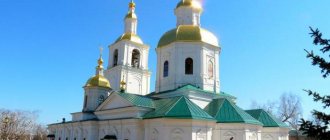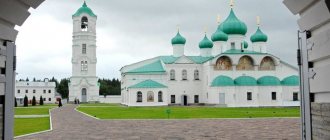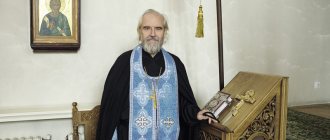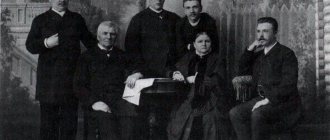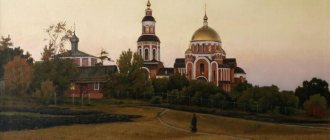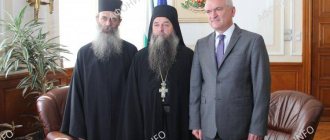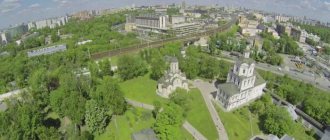At the Shamordino Monastery, Lyudmila was a housekeeper and instead of a quiet monastic life, trips to the authorities began, asking for help in restoring the monastery. Times were difficult, few people responded with sympathy for the holy cause. But obedience and dedication won, the monastery flourished and was built.
While knocking on the thresholds of offices and authorities, Nun Nicholas experienced persecution and black slander, however, she remained faithful to the cause of God, as if the Lord was preparing her for the heavy cross of the abbess.
Our article is about Abbess Nicholas.
Abbess Nikolai Ilyin reads the report “Features of monastic life in the city monastery” at the XXIII International Christmas educational readings. 2015
The father of the future abbess became an example of courage and obedience for her
Lyudmila Ilyina was born on Victory Day, May 9, 1951 in the city of Orekhovo-Zuev, Moscow region. The girl's father, Dmitry Vasilyevich Korolkov, was a tank driver during the Great Patriotic War and reached Berlin. He often told his daughter about the war and how courageously the Soviet Army fought for the Motherland.
Most of all, the future abbess remembered one of his front-line stories.
One day, after a difficult battle, hungry and exhausted, Dmitry Vasilyevich lay down in the dugout to rest a little. Before he had time to close his eyes, the commander’s order for battle sounded again. Dmitry jumped up and immediately ran to his tank, at that very moment a shell hit the dugout.
If he had lingered even for a few seconds, he would have been in danger of imminent death; boards and pieces of earth would have scattered in different directions. Obedience and devotion not only saved the fighter’s life, but also forever became an example of the highest virtue for his daughter, the future mother abbess.
Lyudmila Dmitrievna’s mother went to a monastery in old age
Korolkova Vera Vasilyevna, Lyudmila’s mother, was a nurse during the war years, and followed the same path after the victory, choosing one of the most difficult areas of medicine - the department of psychiatry.
She was very kind and merciful, despite difficult times and persecution, she always had true faith in God.
Having retired, Vera Vasilyevna entered a monastery and until the end of her days served the Lord in the monastic rank with the name Veronica.
Abbess Nicholas at the monastic conference on August 14, 2021 in the refectory of the Chernooskol Monastery
In worldly life, Nikolai’s mother received a good education and worked in the field of programming
Lyudmila was gifted with exact sciences from childhood, she graduated well from school and in 1968 entered the Moscow Institute of Railway Transport Engineers at the Faculty of Electronic Computers.
And in 1984 she also graduated from the Moscow Engineering and Physics Institute with a diploma in the automatic processing of scientific and experimental data.
After graduating from graduate school, in 1987, she worked as the head of the artificial intelligence laboratory at the Instrument Engineering Research Institute.
The biography of Abbess Nikolai Ilyina is an example of how a real spark of love for God can flare up.
Lyudmila Dmitrievna was engaged in science and did not think about monasticism. She often visited monasteries and temples. She especially fell in love with Optina Pustyn, where they predicted that in the future she would have many spiritual children. And Elder Ambrose, who appeared to the woman in a dream, admonished and guided her on the path of salvation.
At the behest of her heart and the instructions of her spiritual father Archimandrite Polycarp, in 1990 Lyudmila went to the Ambrosievsky Stauropegic Convent in Shamordino as an housekeeper.
“Either a dissertation or an apostle”
Abbess Nicholas (Ilyina) Abbess Nicholas (Ilyina) is the abbess of the St. Nicholas Chernoostrovsky Monastery in Maloyaroslavets. A Muscovite, a researcher with two higher educations... How and why did she “trade” pure intellectual pursuits for hard work, almost always dirty and physical, to restore destroyed monasteries, what joy did she find in this?
How I was christened
My parents grew up and were brought up in an atheistic Soviet state and were non-church people, but my great-grandmother really believed in God and went to church. She became my godmother.
My dad and mom are front-line soldiers. Dad, Dmitry Vasilyevich Korolkov, was a tank driver and reached Berlin. My mother, Vera Vasilyevna, worked in a military hospital during the war, and I was born on May 9, Victory Day.
In infancy she was very sick and by July she was dying of pneumonia. The great-grandmother demanded from the parents:
- Let's baptize the baby, otherwise he will die!
Dad was a communist, but did not object. In the 1950s, any baptism was reported to the authorities, and my parents could pay with work, so I was taken to the village, to a rural church, where I was successfully baptized Kazanskaya. I recovered and lived.
Children's prayers
Somehow, from early childhood, I always felt that God existed, and I learned to turn to Him in any difficult circumstances. My godmother taught me two prayers: “May God rise again” and “Alive in the help of the Most High.” She, a simple, illiterate peasant woman, wrote them down for her beloved granddaughter with mistakes, and that’s how I learned them. I realized these mistakes and corrected them while already in the monastery.
My mother also came to the monastery later (after the death of my father) and went to the Lord as a nun in 2011.
With Mother Nikolai in Optina
The soul was drawn to God
In my youth, I liked to study, I received two higher educations (MIIT and MEPhI), worked as the head of a laboratory at a research institute, and at the same time completed graduate school. When I was planning to write my PhD thesis, I studied philosophy. And then I began to think seriously about God and the meaning of existence.
In those years, “Scientific atheism” and “Scientific communism” were compulsory subjects in universities, but the human soul was still drawn to God.
Revival of the Danilov Monastery
In 1983, the revival of the St. Daniel Monastery began. It was closed in 1929, the churches were destroyed, the necropolis was destroyed, and a monument to Lenin was erected in the monastery courtyard. The godless authorities also set up an orphanage in the monastery for children whose parents were shot at the Butovo training ground. The orphans in the reception center often got sick and died, they were buried near the monastery wall.
Danilov became the first monastery in Russia to be returned to the Russian Orthodox Church by the Soviet government (not counting the Trinity-Sergius Lavra, which was transferred to the Church immediately after the war).
I began to spend my postgraduate days at the monastery. I prayed. Washed the floors...
The Lord led me to the reviving St. Daniel Monastery, and I felt such power, such grace! I had scientific and postgraduate days off, which I began to spend at the monastery. I prayed. I was just washing the floors.
One of the fathers (now the Optina schema-monk), knowing about my profession, said about me:
- This is the kind of people who came to us!
And then he saw me with a floor bucket.
Revival of Optina Pustyn
Optina Pustyn
Optina Pustyn. 1988 In 1988, Optina Pustyn was returned to the Church. The ancient monastery lay in ruins. I arrived there in July 1988 and then began to travel constantly. One of my friends worked there cleaning the temple; one day she was going on vacation and asked me to replace her. I stayed to wash the temple, and after that my life became closely connected with Optina.
My first spiritual mentor was Father Polycarp (Nechiporuk; now archimandrite, confessor of the Shamordino Kazan-Amvrosievsky monastery). I met him back in the Danilov Monastery, and then he, together with Archimandrite Evlogii (Smirnov), moved to Optina. Archimandrite Eulogius (now a retired metropolitan) became the governor of Optina Hermitage, and Father Polycarp became the dean.
“Either a dissertation or an apostle”
Following Optina, they began to restore the women's monastery in Shamordino, founded by the Monk Ambrose of Optina, and Father Polycarp was soon blessed there as a builder and confessor. He was very sad about this, and the Monk Ambrose himself even appeared to him and consoled him.
I, like many other spiritual children of Father Polycarp, followed him to Shamordino to help him. Then many dropped out, he sent some away, but I stayed to work.
I took a vacation from my research institute, then a second one, and when there were no more vacations left, I quit. Elder Schema-Archimandrite Mikhail (Balaev; 1924–2009) from the Trinity-Sergius Lavra, the future confessor of our Chernoostrovsky St. Nicholas Monastery, told me:
– Choose: either a dissertation or an apostolate.
And I already understood well that scientific work no longer interested me, that I wanted to be with God.
Shamordino. April 1988 Kazan Cathedral
Obedience of the housekeeper
A month later, I was made the steward of the reviving monastery in Shamordino, although I was not even dressed in a cassock yet. Then she was tonsured a nun with the name Euphrasia in honor of the holy martyr Euphrasia of Nicomedia.
There was a lot of work ahead: the main monastery church - the Kazan Cathedral - stood without domes, trees grew on the rusted roof, combines were driven into the altar. The hospital building, the refectory and all the other monastery buildings were also dying, local residents had long lived in the residential buildings, and a grocery store was located in the brick building erected around the former cell of the great elder Ambrose of Optina.
The first sisters of the monastery, mostly city dwellers, had to live without heating, without running water and other amenities. With their weak women's hands, they restored destroyed temples, cleared rubble, dug out foundations, prepared firewood, hay for livestock, and did a lot of other menial work.
Shamordino. 1990
How the nuns “settled in well”
The reviving monastery was very poor, but the even poorer old women from the village of Shamordino even envied us. Let’s say we’re bringing timber donated to the monastery, and they’re gossiping:
“The nuns are doing well: they don’t do anything, but everything is brought to them!”
To this they were advised:
– And you pray, and they will bring it to you too.
Shamordino. 1992
School of Humility
As a housekeeper, I needed to organize the construction site, get cement and other materials. There was a lot of work, and I also had to go through the school of humility, which was, of course, very useful for me.
Early in the morning I go to the construction brigade and confidently plan: now I’ll quickly scout everyone: one brigade there, another brigade here, a platoon to the right, a platoon to the left... I arrive: one brigade got drunk, the second didn’t show up for work. And with my plans I am left with nothing.
It happened, everything happened completely differently - in the most miraculous way. In the 1990s, cement was hard to find. One day I go to the wiring and reproach myself: “What a useless economist I am! Someone else would have found and done everything long ago, but I can’t even find cement!”
I come up and see: such a “cigar” is driving - a cement truck. The cement has arrived!
"Igumen's" obedience
Having given up a career in the world, I never thought about a career in a monastery. True, the words of Elder Michael puzzled me. He reprimanded his sister, who lived with me in the same cell (now Abbess Mikhail):
– Do not treat nun Euphrasia as a sister, but treat her as a mother!
And from the first days in the monastery, the future Abbess Mikhail and I had one of our favorite pastimes: cleaning latrines. Back then we had them made of wood and usually dirty, but we really wanted them to be clean. In addition, we had our own “self-interest”: we really wanted to acquire more grace, but any monk knows that the most difficult, “black” obedience teaches the soul to humble itself, and therefore attracts the grace of God.
When Mother Abbess Nikona (Peretyagina) found out how we labored in secret, she scolded us, saying:
– You arbitrarily took up the “abbess” obedience, because according to the tradition of old monasteries, those who were intended to be abbots or abbess were appointed to clean toilets.
How to live in a monastery
Once we came to Elder Michael at the Trinity-Sergius Lavra, and he told us:
– You need to live your whole life in a monastery as if you were living there for the first time!
The elder told us: “You need to live your whole life in a monastery as if you were living there for the first time!”
We objected:
- Father, on the first day we ran around the monastery like fools and kissed all the corners of the destroyed churches from the happiness that overwhelmed us...
“You are fools before people, but being like that before God is the most important thing!” So now try to remain such fools throughout your monastic life!
Prayer before the miraculous icon
Once, an Optina hieromonk was invited by Archbishop Clement (now Metropolitan of Kaluga and Borovsk) to the Gorny Monastery as a confessor. He invited me to go to Gorniy with him and on this occasion introduced me to Bishop Clement.
Soon after this, I happened to travel from Shamordino to Kaluga on economic business. And I had a custom: when traveling to Kaluga, I always tried to go to St. George’s Cathedral and venerate the miraculous icon of the Kaluga Mother of God. I go into the courtyard of the cathedral and see that same Optina hieromonk there. He tells me:
“They won’t take me to Jerusalem, but Archbishop Clement wants to meet with you.” Just wait for me until I'm free.
While I was waiting, I went up to the candle box and asked to give me an akathist to the Kaluga Icon of the Mother of God. I was given the seventh issue of the Orthodox Christian magazine for 1991 with an akathist.
I open the magazine and a note catches my eye: the Chernoostrovsky St. Nicholas Monastery has been opened. The same one where my sisters and I are now asceticizing.
I go up to the miraculous icon of the Mother of God, begin to pray - and suddenly a lamp is spilled right on my head
I go up to the miraculous icon of the Mother of God and begin to pray, and suddenly a lamp is spilled right on my head. And when I went to the candle shop to return the magazine, they gave it to me.
Chernoostrovsky St. Nicholas Monastery during the years of devastation
Unexpected tears
When I approached Bishop Clement, he, completely unexpectedly for me, suggested:
– Ancient monasteries are being revived, there are not enough inhabitants and those who could lead them. Would you like to be an abbess in a reviving monastery?
- Sorry, sir, I don’t want to!
- Why?
- Because I can’t properly answer for myself before the Lord, let alone for others...
And then he told me words that were terrible for me at that time:
– What if we, with our archpastoral authority, put a cross on you and make you an abbess?
And I became so scared that I started crying.
As I later learned, the bishop cannot stand women’s tears. He didn’t say anything more to me and immediately sent me out, but, as I understand now, he began to pray. And everyone knows that our bishop’s prayer is very powerful.
St. Nicholas Church in the Chernoostrovsky Monastery
Now be a cook
This conversation happened on the Ascension, and already on the Assumption I, the Shamordino steward, was sent as a cook to the diocese. And I thought to myself: I gave up the abbess, now be a cook.
And Vladyka, apparently, just wanted to humble me, on the one hand, and to get to know me better, on the other.
The abbot's cross cannot be abandoned
Elder Michael, in response to my story about the bishop’s proposal, said:
– You cannot refuse the abbot’s cross, otherwise there will be great temptations!
Then the bishop called me a second time and suggested:
- Let's continue our conversation.
But I was already “smart” and answered:
– Vladyka, I still don’t want to be an abbess, but I’m already afraid to refuse.
And then she added confidently:
“And yet it seems to me that this is not the will of God.”
Bishop Clement offered me the Kazan Monastery in Kaluga. Then troubles began in the reviving Chernoostrovsky St. Nicholas Monastery, and the Bishop was forced to close it, and sent me to revive it as a women’s monastery.
Chernoostrovsky St. Nicholas Monastery. 1992
First visit to Maloyaroslavets
When I first came to Maloyaroslavets, I really didn’t like the destroyed Chernoostrovsky monastery: everything around was terribly dirty, everything was foreign. (And I really loved Shamordino.)
Behind the ruins and piles of garbage, I didn’t even see the big St. Nicholas Cathedral
We arrived late in the evening, it was already dark, and behind the ruins and piles of garbage I didn’t even immediately see the large St. Nicholas Cathedral. And no wonder: he was immersed in darkness and dressed from top to bottom in rotten wooden scaffolding, and the wind was blowing inside. The only small Korsun church operating at that time was heated with coal. A significant part of the surviving monastery buildings lay in ruins. Whole packs of hungry stray dogs ran and howled around the territory of the monastery.
Is this how you usually imagine your dream monastery? I thought: this is for life?!
Chernoostrovsky St. Nicholas Monastery. 1991
How I turned to Elder Moses of Optina for help
Everyone tried to dissuade me:
- Where are you driving?! Where are you going in Maloyaroslavets?!
I’m walking, and suddenly they give me a book. I open - the life of the Optina elder Moses, the elder brother of the elder Anthony, who was sent to the Maloyaroslavets monastery by the abbot.
I started to pray:
- Dear Elder Moses, tell me: is it God’s will for me to become an abbess in Maloyaroslavets?
I open the book and read Elder Moses’ letter to his brother: “If you are to be abbot of Maloyaroslavets, then approach this with all care and humility.”
Prayer to St. Ambrose of Optina
I fervently prayed to the Monk Ambrose of Optina, asking the saint to send me sisters, at least a few, at least five, ten, fifteen people, and the reverend mercifully answered my prayer: 30 young girls from Optina almost simultaneously arrived at our Chernoostrovsky monastery. Many of them were Muscovites and had higher education.
By the decision of the Holy Synod on April 2, 1992, the Chernoostrovsky St. Nicholas Convent was opened.
Pray and work
Residents of Maloyaroslavets, brought up, like all of us, during the years of Soviet atheism, could not understand how they could exchange their life and successful career in Moscow for menial labor in a destroyed monastery somewhere in the outback. They came up with different versions, one of which said that the sisters gathered here were actually prisoners who were given a choice by the authorities: either sit in prison or rebuild the monastery.
It is very difficult for an unbeliever to imagine that it is possible, of his own free will, to come to ruin, dirt, and the lack of basic everyday amenities.
Nevertheless, we arrived. In fact, the sisters, accustomed to comfortable city life, actually had nowhere to live in the then destroyed monastery. There was no hot water either. Yes, how hot, there was simply no water, it flowed only in the source. Then they donated ceramic batteries to us - they are usually installed in barnyards.
But we did not lose heart; there was not enough time to be sad. It was necessary to pray and work: roll up our sleeves, install water and heating into the buildings, restore the beautiful cathedral and the wonderful ancient monastery.
His Holiness Patriarch Alexy II and Archbishop Clement in the St. Nicholas Monastery. 1999
A journey of 27 years
Now our monastery is 27 years old, and over these years, of course, many events have happened: temptations and sorrows, joys and spiritual discoveries.
Perhaps I'll talk about this next time.
God bless all readers of the Pravoslavie.ru portal!
Chernoostrovsky St. Nicholas Monastery
Chernoostrovsky St. Nicholas Monastery now
Street children began to be brought to the ruined uninhabited monastery
At the beginning of 1993, the Holy Synod decided that the St. Nicholas Monastery should be a women's monastery. Mother Nicholas came to the devastated monastery with only one novice, and already in 1995, for her diligent service for the good of the Church, by decree of His Holiness Patriarch Alexy II, she was elevated to the rank of abbess and was awarded the abbot’s baton.
Pupils of the Otrada shelter in the children's refectory during lunch. Girls of all ages dine as a friendly family at the same table
At that time, only 50 sisters lived in the monastery. Together with the nuns, children lived - street children who had come to the monastery. As much as they could, the mother and sisters of our monastery tried to provide life, food, education and leisure for the young children.
There was a catastrophic lack of funds and living quarters. However, with the blessing of Patriarch Alexy II of Moscow, the sisters organized a shelter for girls from disadvantaged families and orphans at the monastery.
The shelter was named “Otrada” in honor of the icon of the Mother of God “Consolation and Consolation”.
Today, for girls from the Otrada shelter, there is a unique system of continuous education, consisting of a children’s gymnasium and a comprehensive school. For those wishing to obtain higher education - a remote laboratory of the Russian Social University, Department of Orthodox Journalism.
Fifty girls aged from two to seventeen years live and study in the orphanage.
The monastery shelter is also famous for its choir, which has repeatedly won prizes at various international competitions. The girls performed in Tel Aviv, Cyprus, Limassol, Vienna, Salzburg, and other places around the world.
Abbess Nicholas, abbess of the Chernoostrovsky monastery with pupils of the monatsyr orphanage "Otrada" at prayer before a choir rehearsal
Is she a vessel in which there is emptiness, or a Fire flickering in the vessel?
The radiant, joyful and open look of a child is disarming and, without any words, tells about the well-being of the family - in this case, the monastic one. The children at the orphanage often smile, many of them wear braces - an expensive system for creating a “Hollywood” smile these days.
- Girls, what is beauty? Which girl or woman do you think is beautiful?
– A woman is beautiful when, first of all, she has a good soul. This is the beauty of her soul,” says Anechka Mezhelovskaya , a girl of about twelve.
– But a smile should also be beautiful? You wear braces, don't you?
– We perform on stage – we dance, we sing, so we need it! – Anya is sure.
Schema-Archimandrite Vlasiy (Peregontsev) after the monastic tonsure of the novices of the monastery
Indeed, today the artistic team of the Otrada shelter - winner of many international competitions and festivals - is known in different countries of the world, favored by the attention of the clergy and the Athonite elders. Together with Elder Ephraim, abbot of the Athos monastery of Vatopedi, the girls participate in the “Light in the Universe” concerts and conferences. All 100% of the orphanage’s pupils study music, practice choreography and choral singing at the Maloyaroslavets School of Arts, again within the walls of the monastery. The choir is led by Arkady Sagaidak from the ensemble of ancient Russian sacred music “Sirin”, he is assisted by the dean of the monastery, a graduate of the State Conservatory. Rachmaninov in Rostov-on-Don nun Seraphima (Tuboltseva).
It is interesting that concert dresses for performances, embroidered with beads, sparkling with rhinestones and appliqués - the subject of sincere admiration of professional costume designers - are sewn by the sisters of the monastery with the direct participation of girls.
Concert dresses are sewn by the sisters of the monastery with the participation of students
Once, at a concert of the children's group "Otrada", our regular author, Konstantin Mikhailovich Dolgov, a man of encyclopedic knowledge, fluent in two dozen languages, Doctor of Philosophy, once a member of the CPSU Central Committee, teacher of philosophy, aesthetics, diplomacy, culture in many universities around the world, appeared for 60 years. “I was simply stunned,” Konstantin Mikhailovich shared his impressions, “I have never heard anything like at this concert of abandoned orphans, and now absolutely amazing girls, from any great artist. I deliberately listened carefully, hoping to notice some musical flaws. Flawless. Two or three works were dedicated to Athos and were performed in Greek, followed by chants in Serbian, Bulgarian, Church Slavonic and Russian.”
In 2005, construction and repair work at the monastery was completed
The long and hard work of restoring the monastery began. With the aspirations of Mother Nikolai, the obedience of sisters and workers, the help of philanthropists, with prayer and love, all construction and restoration work was completed in 2005.
St. Nicholas Church and the Cathedral of All Saints received new life. A bathhouse was built over the spring of St. Nicholas, the fraternal building was expanded and a two-story shelter building was erected. A new children's refectory has been decorated, where sisters, girls and guests gather.
The Chernoostrovsky monastery is famous for its cheese factory, where the sisters prepare cheese
The Chernoostrovsky monastery in Maloyaroslavets, organized by Mother Nicholas and living according to the strict Athos Rule, has already educated and graduated fifteen abbess, who successfully serve as abbots in various monasteries in Russia.
One hundred and twenty sisters labor in the Nikolskaya Hermitage. As the sisters themselves say: “We don’t do anything special—we work, we pray, we bring people joy and faith.”
No rule against abortion
– Mother, many modern children suffer because of the sins of their parents, including abortion. Schema-nun Antonia (Kaveshnikova), who distributed a special prayer rule to women who had abortions, is buried in the monastery cemetery.
– Mother Antonia’s “rule” is a heresy; it proposes to baptize unborn babies and call them Christian names – this contradicts the teachings of the holy fathers of the Orthodox Church. “There is no rule against abortion,” these are the words of Father Kirill (Pavlov), to whom I turned for advice on this issue. You have to remember your sin all your life and cry about it all your life. And so it turns out - you killed, told off for 40 days, named him, and even baptized the unborn - and you are free. A person must repent throughout his life.
At prayer
If such people come now, we say: there are the relics of St. Nicholas, we have a lot of relics of saints in the church - pray. But there is no need to look for pseudo-saints.
– Are there any schema-monks or elders in the monastery today?
- Eat. For example, the schema nun is the mother of Metropolitan Clement, Mother Maria, in honor of Equal-to-the-Apostles Mary Magdalene, she is now 101 years old.
Mother Nicholas was awarded many orders and medals for her services and labors.
For her work in restoring the monastery and for her services to the fatherland, Abbess Nikolai Ilyina was awarded fifteen awards: two state orders and seven church orders, as well as six medals, three of which were state awards.
In 2012, Russian President Vladimir Putin personally presented Mother with the first restored Order of the Holy Great Martyr Catherine “For Works of Mercy.”
One of the prides of the shelter is the honor board for graduates of the Orthodox gymnasium at the St. Nicholas Monastery
Abbess Nicholas and the St. Nicholas Chernoostrovsky Monastery invite pilgrims and guests to get acquainted with the life of a modern monastery with accommodation in the hostel of the Spiritual and Educational Center at the address: Kaluga region, Maloyaroslavets city, Kutuzova street, house 23.
About the date of arrival and the number of guests, write to the following email address:
The gates of the St. Nicholas Chernoostrovsky Monastery are always open to parishioners and pilgrims
By leaving a comment, you accept the user agreement
